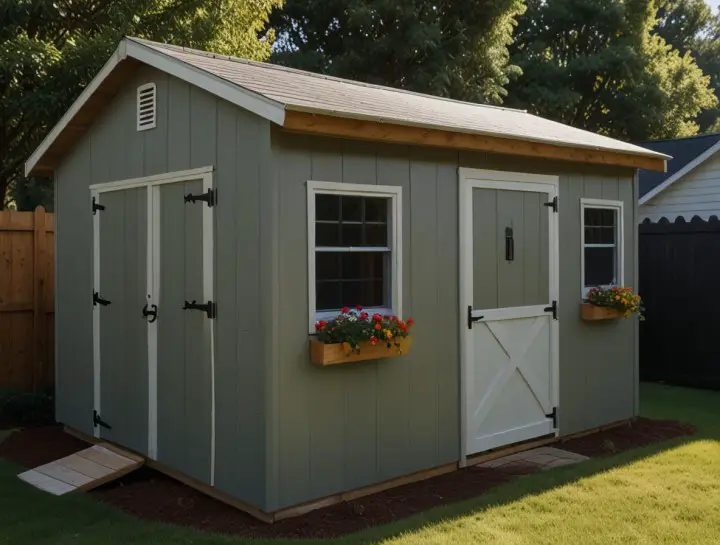How to Build a Sliding Wooden Gate? 7 Pro Steps
Overview
A sliding wooden gate offers a robust, space-saving solution for property entrances. Compared to traditional swing gates, sliding gates are ideal when space is limited, and they provide a sleek, modern appearance. Whether you’re enhancing security or boosting curb appeal, building a wooden sliding gate requires careful planning, precise measurements, and durable materials. Follow these comprehensive steps to construct a sliding wooden gate that stands the test of time.
1. Planning and Preparation
Before diving into construction, thorough planning is essential. Understanding the gate’s dimensions, the materials needed, and the gate’s track system is critical for a smooth build. Here’s what you need to consider:
1.1 Measure the Opening
Start by accurately measuring the width of the entrance where you intend to install the sliding gate. Use a tape measure to determine both the height and width of the opening. Remember, the gate should cover the entire width, with enough clearance for smooth sliding.
- Measure the total width, adding extra clearance for the gate to overlap when closed.
- Ensure enough space is available for the gate to slide fully open without obstruction.
- Take note of any slopes or uneven terrain, as this can affect the gate’s installation and movement.
1.2 Choose Quality Materials
When building a sliding wooden gate, material quality is paramount. Opt for durable wood, such as cedar or redwood, as these species are naturally resistant to rot, pests, and weathering. Select rust-resistant hardware, including heavy-duty tracks and rollers, to ensure longevity.
- Cedar and redwood are excellent for their resistance to moisture and insects.
- Use stainless steel or galvanized metal hardware to prevent rust.
- High-grade rollers and tracks ensure the gate moves smoothly and securely.
2. Gathering Tools and Materials
Once you have your measurements and chosen materials, gather all necessary tools and equipment. Proper tools will make the construction process more efficient and ensure that your sliding wooden gate functions correctly for years to come.
2.1 Tools Needed
- Tape measure
- Level
- Drill
- Saw (circular or hand saw)
- Hammer
- Screwdriver
- Concrete mix (for post anchors)
- Wrench set
- Wood screws and bolts
2.2 Materials Required
- Wooden planks (size dependent on your measurements)
- Posts (for mounting the track)
- Sliding gate track and rollers
- Guide rails and support brackets
- Stain or sealant (to protect the wood from the elements)
3. Installing the Gate Posts
The foundation of your sliding gate begins with the posts. These posts will support the track on which the gate slides. Correctly positioning and securing these posts ensures the longevity and stability of your sliding wooden gate.
3.1 Mark the Post Locations
Start by marking where the posts will be placed. You’ll need at least two posts: one on each side of the opening. For larger gates, consider additional support posts.
- Ensure the posts are aligned perfectly with the gate’s intended path.
- Use a level to verify the posts are straight both vertically and horizontally.
3.2 Dig Post Holes
Dig holes for your posts deep enough to secure them firmly. A depth of at least 2-3 feet is recommended, depending on the height and weight of the gate. Make sure the post holes are deep enough to prevent leaning or instability over time.
- Use a post hole digger or an auger for efficient digging.
- Place gravel at the bottom of each hole for drainage, helping to prevent wood rot.
3.3 Secure Posts in Concrete
Set the posts in place using concrete to anchor them firmly. Allow the concrete to dry for at least 24-48 hours before moving on to the next steps.
- Mix the concrete according to the manufacturer’s instructions.
- Ensure the posts are level and straight while the concrete sets.
4. Constructing the Sliding Gate Frame
The next step is constructing the actual gate frame. A sturdy frame is key to ensuring the gate’s longevity and resistance to sagging or warping.
4.1 Cut the Frame Components
Using your measurements, cut the wooden planks for the gate frame. The frame typically consists of two horizontal planks (top and bottom rails) and two vertical planks (side stiles), with additional cross-bracing to reinforce the structure.
- Use a saw to cut planks to the required lengths.
- Sand down any rough edges to ensure a smooth finish.
4.2 Assemble the Frame
Lay the frame components on a flat surface and begin assembly. Secure the planks together using wood screws or bolts, ensuring the frame is square and stable.
- Check alignment with a carpenter’s square.
- Add diagonal bracing if necessary to prevent sagging.
4.3 Attach the Slats or Panels
Once the frame is complete, attach the wooden slats or panels to the frame. You can choose to install the slats horizontally, vertically, or in a custom pattern to enhance the gate’s visual appeal.
- Space the slats evenly for a balanced appearance.
- Use weather-resistant screws to fasten the slats to the frame.
5. Installing the Sliding Mechanism
The sliding mechanism is what sets this type of gate apart from others. A well-installed track system will ensure smooth, reliable operation for years to come.
5.1 Install the Sliding Track
The track will guide the gate along its path. Depending on your design, the track can either be installed on the ground or mounted to the fence or wall.
- Ensure the track is level and secure to prevent any disruptions in the gate’s movement.
- Use a wrench set to tighten bolts and fasteners.
5.2 Mount the Rollers
Attach the rollers to the bottom of the gate frame. These rollers will ride along the track, allowing the gate to slide open and closed smoothly.
- Check the manufacturer’s guidelines for proper roller installation.
- Ensure the rollers are heavy-duty and can support the gate’s weight.
5.3 Install Guide Rails
Guide rails will prevent the gate from swinging out of alignment. Attach the guide rails to the post or wall where the gate slides, ensuring they line up perfectly with the gate.
- Use a level to ensure the guide rails are straight.
- Tighten all bolts and fasteners securely.
6. Finishing Touches and Gate Testing
With the gate and track system installed, it’s time for the final touches. Ensure the gate functions smoothly and apply any finishing treatments to the wood to enhance its durability.
6.1 Sand and Stain the Gate
To protect the gate from weathering, sand the entire surface and apply a high-quality wood stain or sealant. This will shield the wood from moisture, UV damage, and pests.
- Use an exterior-grade wood finish for the best results.
- Apply multiple coats for added protection.
6.2 Test the Gate’s Operation
Once the stain has dried, test the gate to ensure smooth operation. Open and close the gate multiple times to confirm it slides easily along the track.
- Adjust the rollers or track if the gate is not moving smoothly.
- Ensure the gate locks securely when closed.
Conclusion
Building a sliding wooden gate is a rewarding project that combines craftsmanship with practicality. By carefully selecting quality materials, following precise measurements, and installing a reliable sliding mechanism, you can create a durable and attractive gate that enhances both the security and aesthetic of your property.







